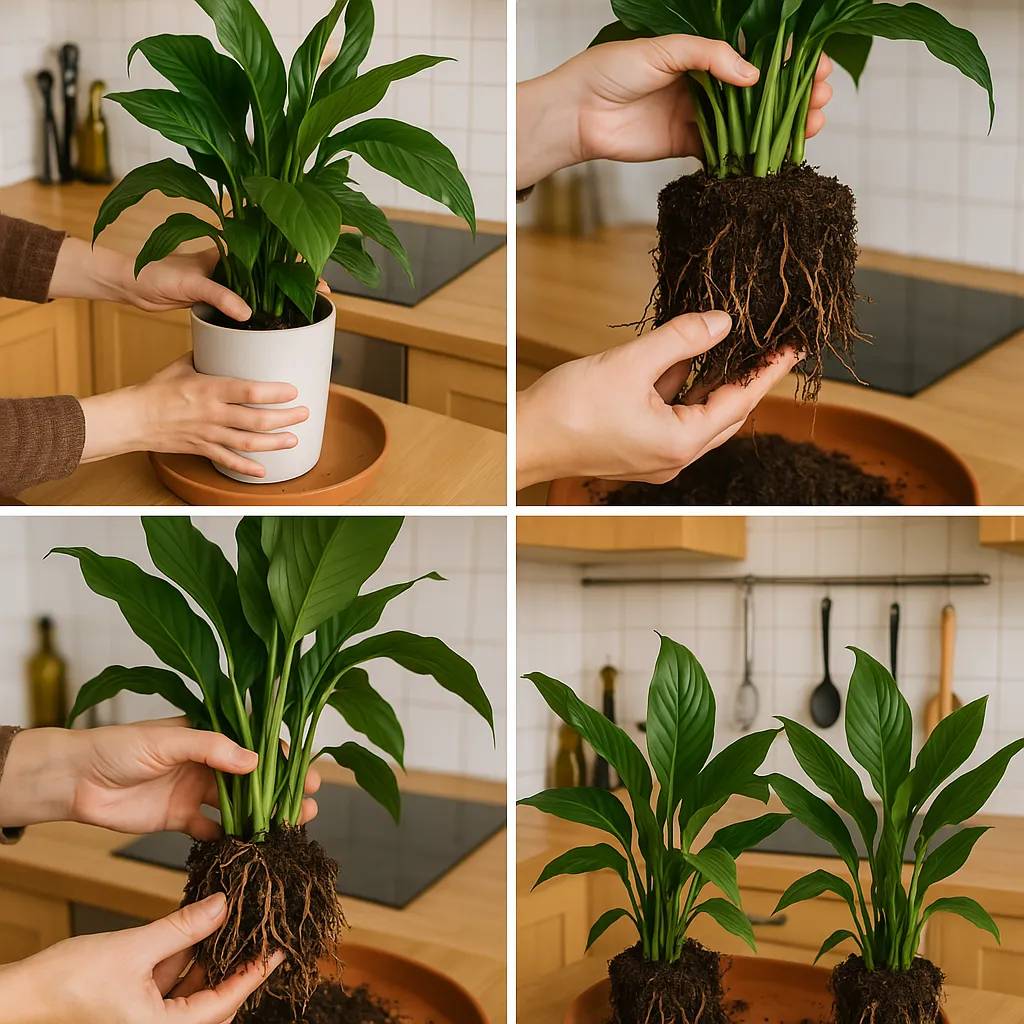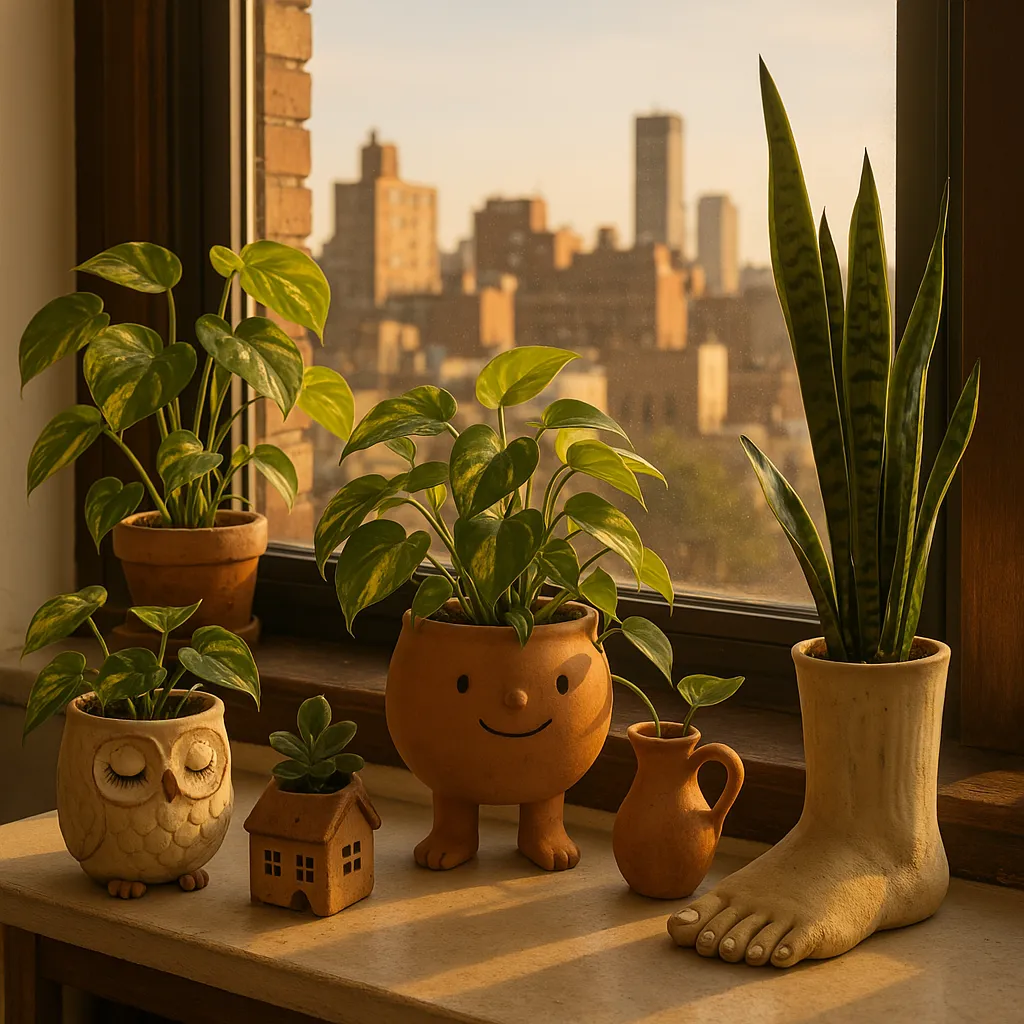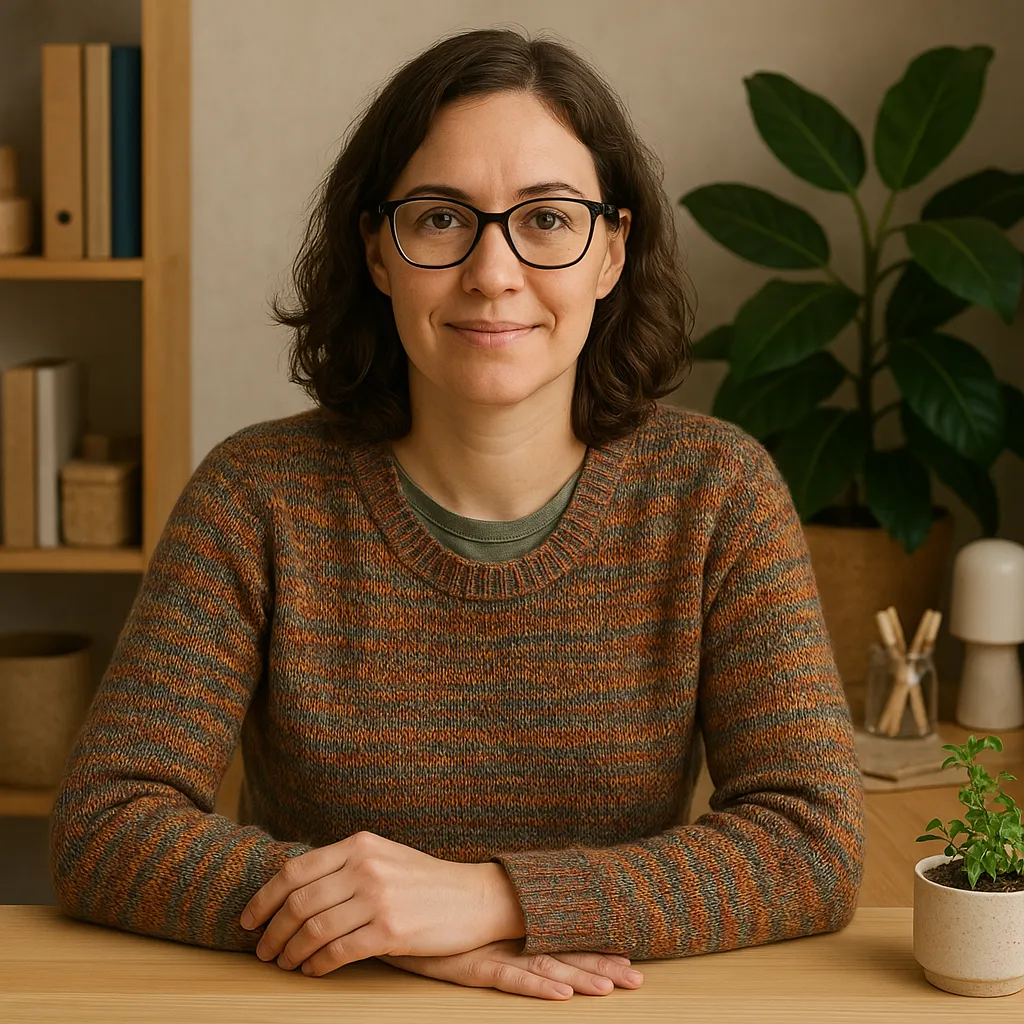
Sage T.
Indoor Gardening & Plant Care
Why Humidity Matters for Indoor Plants
If you’ve ever noticed your houseplants looking a little sad—think crispy brown leaf tips or leaves curling inwards—you’re not alone. Many popular indoor plants, especially tropical varieties like ferns, calatheas, and monsteras, crave more humidity than what’s typically found in urban apartments.

Humidity is simply the amount of moisture in the air, and it plays a big role in plant health. In their natural habitats, tropical plants thrive in warm, moist environments where the air is almost always humid. When we bring these plants indoors, especially into apartments with dry, heated air or air conditioning, they can struggle. Low indoor plant humidity can cause leaves to dry out, growth to slow, and plants to look less vibrant overall.
Urban living often means smaller spaces and less control over the environment. Radiators, central heating, and even air conditioners can make apartment air much drier than what your plants are used to. If you’re new to apartment gardening or just starting your plant care for beginners journey, don’t worry—understanding humidity is the first step to helping your indoor jungle thrive, no matter how small your space. In the next sections, I’ll share simple, budget-friendly ways to boost humidity and keep your plants happy and healthy.
Which Houseplants Need Extra Humidity?
If you’re looking to add some lush, vibrant greenery to your apartment, humidity-loving houseplants are a fantastic choice. Many popular tropical indoor plants—like calatheas, ferns, orchids, and prayer plants—naturally thrive in environments with higher moisture in the air. Here’s a quick guide to some of the best humidity-loving houseplants and why they love a little extra mist:
- Calatheas: Known for their striking leaf patterns, calatheas are true showstoppers. They come from rainforest floors, so they’re happiest with consistent moisture. If their leaves start to curl or get crispy edges, it’s a sign they need more humidity.
- Ferns: Boston ferns and maidenhair ferns are classic apartment plant care favourites. Their delicate fronds soak up moisture from the air. If you notice browning or dropping leaves, your fern is likely craving more humidity.
- Orchids: These elegant tropical indoor plants love a steamy bathroom or a spot near a humidifier. Wrinkled leaves or buds that drop before opening can mean your orchid needs a boost in moisture.
- Prayer Plants (Maranta): With their unique habit of folding leaves at night, prayer plants add movement and color to your space. They’re happiest when the air isn’t too dry—look for brown tips as a gentle nudge to increase humidity.
If you spot any of these signs, don’t worry! Most humidity-loving houseplants bounce back quickly with a little extra care. Try grouping your plants together, misting them, or placing a tray of water nearby to gently raise the humidity. Remember, even in a small apartment, you can create a cozy, plant-friendly oasis—no fancy equipment required.
DIY Moisture-Boosting Methods for Small Spaces
If your apartment air feels more desert than rainforest, you’re not alone—urban living often means dry indoor air, especially in winter. But you don’t need a fancy greenhouse or expensive gadgets to keep your houseplants happy. Here are my favorite humidity hacks for apartments, all tested in my own small rental (with zero wall damage or budget blowouts):
1. Grouping Plants Together
- How it works: Plants naturally release moisture through a process called transpiration. When you cluster them, the humidity around their leaves increases, creating a mini microclimate.
- Step-by-step:
- Arrange your plants close together, ideally on a shelf or table near a window.
- Mix leafy and moisture-loving varieties for best results.
- Pros: Free, easy, and instantly boosts humidity.
- Cons: Can look crowded if you have limited space; not as effective for just one or two plants.
- Small space tip: Use vertical plant stands or wall-mounted shelves (with landlord-friendly adhesive hooks) to maximize your grouping without sacrificing floor space.
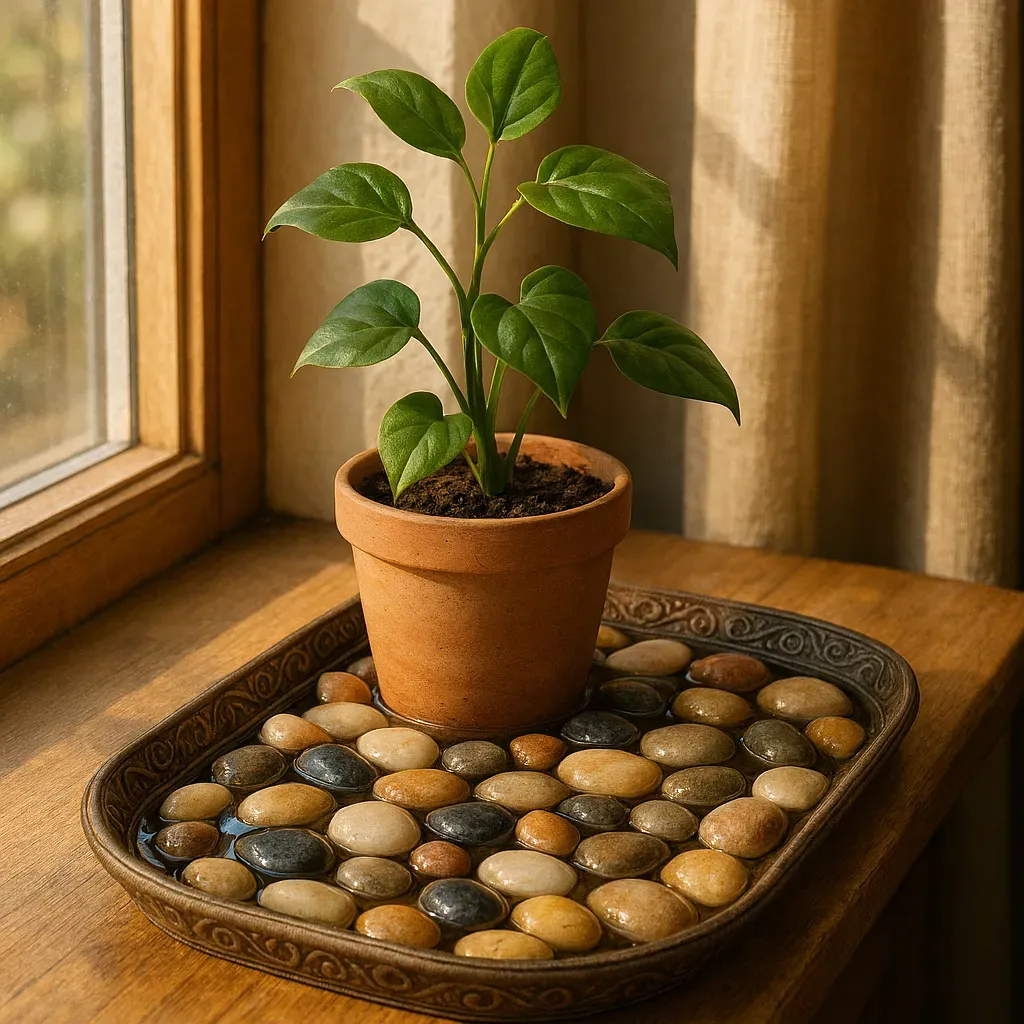
2. Pebble Tray for Houseplants
- How it works: A shallow tray filled with pebbles and water sits under your plant pot. As the water evaporates, it gently raises humidity around the plant.
- Step-by-step:
- Grab a shallow dish or tray and fill it with a single layer of pebbles or small stones.
- Add water until it just reaches the top of the pebbles (but doesn’t touch the pot’s base).
- Place your plant pot on top of the pebbles.
- Pros: Inexpensive, renter-friendly, and works for individual plants.
- Cons: Needs regular refilling; won’t humidify a whole room.
- Small space tip: Use decorative saucers or thrifted plates to match your décor and save counter space. For a more polished look that also protects your surfaces, consider the BELLE VOUS White Ceramic Rectangular Succulent Pots with Bamboo Trays (2 Pack), which come with matching bamboo trays to catch excess water and keep your setup tidy.
3. Plant Misting Tips
- How it works: Spritzing leaves with water gives a quick humidity boost, especially for tropical plants.
- Step-by-step:
- Fill a clean spray bottle with room-temperature water.
- Lightly mist the tops and undersides of leaves in the morning (so leaves dry by night).
- Avoid over-misting—once or twice a week is plenty for most houseplants.
- Pros: Super affordable and easy to do.
- Cons: Effects are short-lived; not all plants love misting (avoid for fuzzy-leafed varieties).
- Small space tip: Keep a small mister handy on your plant shelf for quick spray during your morning routine.
These simple, budget-friendly methods can make a noticeable difference for your leafy friends—no greenhouse required. If you’re curious about more advanced options, check out my reviews of compact humidifiers and self-watering pots for apartments. But for most renters, these DIY tricks are a great place to start!
Smart Tools to Boost and Monitor Humidity
If you’ve ever noticed crispy leaf edges or slow plant growth, low humidity might be the culprit—especially in heated or air-conditioned apartments. Luckily, you don’t need a greenhouse or a big budget to create a plant-friendly microclimate. Here are my top affordable, space-saving tools for boosting and tracking humidity, all tested in my own small-space setup:
1. Mini Ultrasonic Humidifiers
These compact devices use ultrasonic vibrations to turn water into a fine mist, gently raising humidity around your plants. I’ve found models labeled as ‘mini ultrasonic humidifier UK’ or ‘portable plant humidifier’ to be especially effective for small rooms or grouped plant corners. They’re quiet, energy-efficient, and easy to tuck onto a shelf or windowsill. Best for: renters and anyone with limited space. Look for models with auto shut-off and easy-to-clean tanks for hassle-free use. If you’re looking for a reliable option, the raydrop Mini Ultrasonic Humidifier is compact and space-saving, making it ideal for apartments.
2. Digital Hygrometers for Houseplants
A digital hygrometer is a must-have for tracking humidity levels accurately. Search for ‘digital hygrometer for houseplants’ or ‘indoor humidity monitor’—these are inexpensive, battery-powered gadgets that give real-time readings. I keep one near my most sensitive plants to avoid over- or under-humidifying. Best for: beginners and anyone wanting to take the guesswork out of plant care. Choose a model with a clear display and a compact design that won’t clutter your space. The NOKLEAD Thermometer Humidity Meter is a great choice—it’s compact, accurate, and easy to use in any room.
3. Mini Greenhouse Domes for Seedlings
For propagation or nurturing humidity-loving cuttings, ‘mini greenhouse dome for seedlings’ or ‘humidity dome for plants’ are game-changers. These clear, vented covers trap moisture and warmth, creating a stable environment for new growth. I recommend them for anyone starting seeds or rooting cuttings on a windowsill—especially if you’re short on space or can’t make permanent changes to your home. Look for domes that fit standard trays and are easy to clean and store.
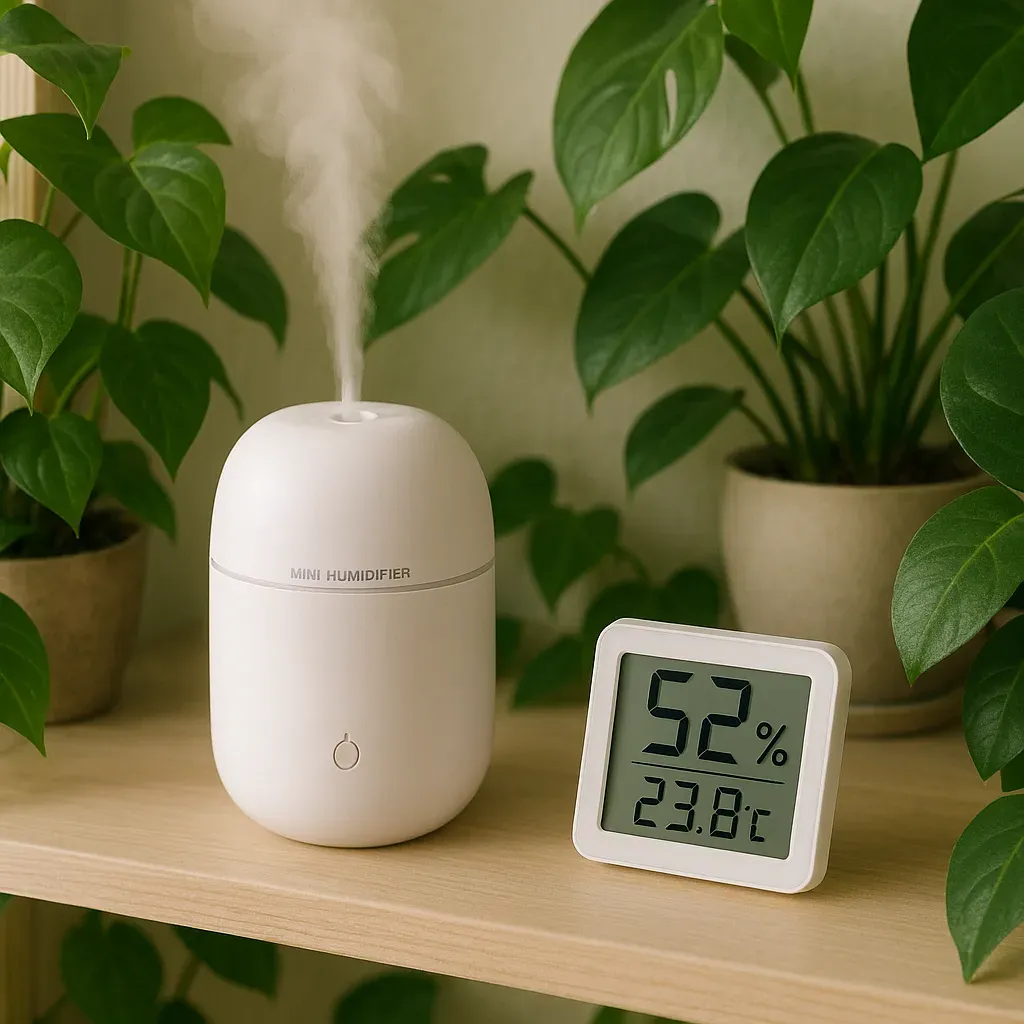
Practical Tips & Gentle Recommendations
When choosing humidity tools, consider your plant collection size, available surfaces, and how much maintenance you’re willing to do. For most apartment dwellers, a mini humidifier paired with a digital hygrometer is a renter-friendly, low-commitment combo. If you’re propagating, a humidity dome is a simple, reusable solution. I’ve tested several affordable options and found that even budget models can make a noticeable difference—just check reviews for reliability and ease of cleaning.
Ready to give your plants a humidity boost? Start with a quick search for the keywords above, and you’ll find plenty of options that fit both your space and your budget.
Quick Troubleshooting: Signs Your Plants Need More Humidity
Not sure if your leafy friends are struggling with dry indoor air? Here’s a beginner-friendly checklist to help you spot common plant humidity problems:
Checklist: Signs Your Plants Need More Humidity
- Crispy or brown leaf edges
- Leaves curling or wrinkling
- Slow or stunted growth
- Leaf drop (especially in new growth)
- Wilting, even when soil is moist
- Flower buds falling off before opening
If you notice any of these symptoms, don’t worry—these are common signs that your plants need a little extra moisture in the air. Here are some easy plant care tips to fix dry indoor air for plants:
- Group your plants together: Plants naturally release moisture, so clustering them creates a mini-humid zone.
- Mist your plants: A gentle spritz in the morning can help, especially for humidity-loving varieties.
- Use a pebble tray: Place a shallow tray filled with water and pebbles under your plant pot (make sure the pot isn’t sitting directly in water). The BELLE VOUS White Ceramic Rectangular Succulent Pots with Bamboo Trays are a stylish, practical option for this method.
- Try a small humidifier: Even a budget-friendly model like the raydrop Mini Ultrasonic Humidifier can make a big difference in a dry apartment.
- Monitor humidity: Use a NOKLEAD Thermometer Humidity Meter to keep an eye on your indoor environment and adjust as needed.
Remember, every home is different—so experiment with these solutions and see what works best for your space. If you’re curious about tools or methods, check out the earlier sections for my tested recommendations. With a few simple tweaks, you’ll be well on your way to happier, healthier houseplants!
Bringing It All Together: Your Renter-Friendly Humidity Plan
Creating a thriving indoor jungle doesn’t require a greenhouse—or even a backyard. The key takeaways? Start simple: even small changes, like grouping your plants or placing a tray of water nearby, can make a noticeable difference in humidity. If you’re ready to invest a little more, consider a compact humidifier or one of the budget-friendly self-watering accessories I’ve tested and recommended.
Remember, there’s no one-size-fits-all solution. Your perfect humidity hack depends on your space, your plants, and your lifestyle. Don’t be afraid to experiment—try a DIY pebble tray this week, or test out a portable humidifier in your favourite plant corner. Every small step brings you closer to a lush, healthy home.
Ready to take the next step? Check out my top product picks or start with a simple DIY method from this guide. No matter your budget or experience, you can create a happy, healthy indoor jungle—no greenhouse required. Find your perfect humidity hack today!
